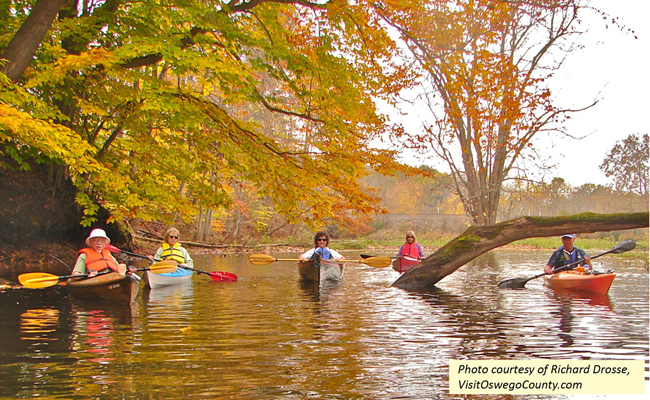
As these kayakers show, it's just as important to wear you life vest during your time on the water this fall. Credit: Richard Drosse and VisitOswegoCounty.com
Contacts:
Dave White, New York Sea Grant, Recreation and Tourism Specialist, P: 315-312- 3042, E: dgw9@cornell.edu
Kara Lynn Dunn, NYSG Great Lakes Publicist, P: 315.465.7578, E: karalynn@gisco.net
Oswego NY, October 10, 2017 - River enthusiasts who stay year-round are hardy souls well-prepared for cooler temperatures and seasonal weather. For those who enjoy kayaking, canoeing or using a row boat late in the year, New York Sea Grant Extension of Cornell University offers a reminder about New York State legal requirements and eight tips to enhance seasonal water safety.
Water that is less than 70 degrees Fahrenheit can lower body temperature and lead to life-threatening hypothermia. According to the U.S. Coast Guard, a body can cool 25 times faster in cold water than in air, children cool faster than adults; and smaller people cool faster than larger individuals.
“New York Sea Grant issues an annual reminder about life vests that are required to be worn by State law starting November 1 but are a good idea whenever the weather turns cooler. These safety tips are meant to help make anyone who gets in trouble on the water more buoyant and more visible to extend the opportunity for rescue and survival,” said New York Sea Grant Coastal Recreation and Tourism Specialist Dave White.
- Wear a life vest.
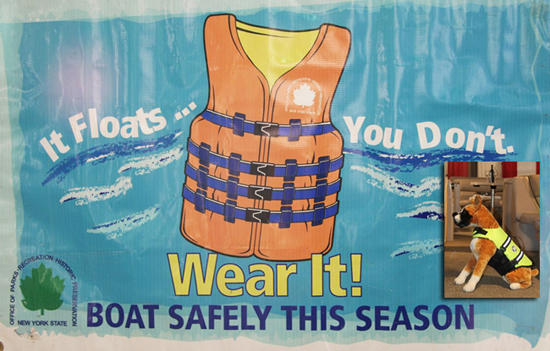
New York State law requires that everyone in a recreational vessel of 21 feet or less must wear a US Coast Guard-approved personal flotation device, or PFD, from November 1 to May 1. A PFD should be in good condition and appropriately sized for snug fit, particularly check that for children their head will not slip through; bright color and attached whistle are recommended.
And don't forget that all passengers means ALL.
- Learn the types of approved PFDs to make the best choice for safety and activity.
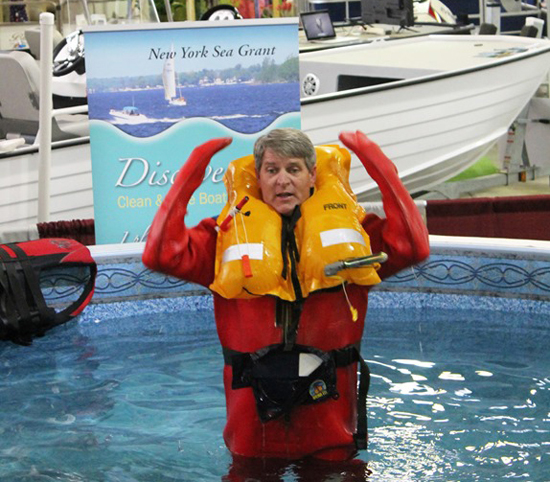
A variety of US Coast Guard-approved floatation devices, beyond the commonly thought of life vest, are available to provide buoyancy. For example, a floatation coat covers the torso. A float suit encloses most of the body to provide buoyancy. One-piece immersion suits cover head, body, feet and hands, leaving only the face exposed.
- Communicate your activity plan, or float plan, to a responsible individual on shore.
When you are leaving, where you entering and exiting the water, where you are going on the water, and when you expect to return. Contact that individual upon your return so they know you have safely returned.
- Use the buddy system.
- Use reflective Safe ‘n Sight paddle decals to increase your visibility on the water.
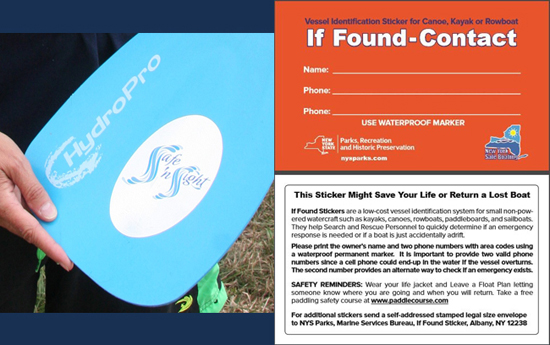
An "If Found: Contact" sticker may be attached to your vessel. The decals can be requested by sending a self-addressed, stamped envelope to NYS Parks Marine Services Bureau, Safe ‘n Sight Stickers, Albany, NY 12238. A street address is not required.
- In the water, use the Heat Escape Lessening Position known as HELP.
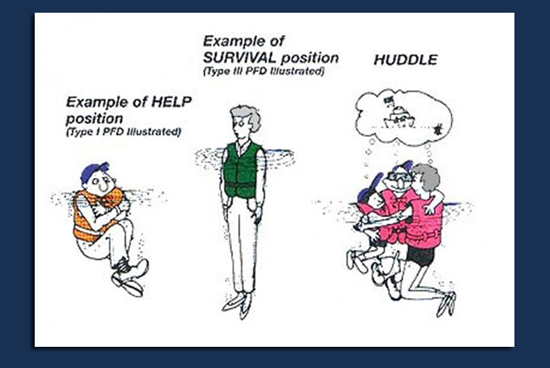
For a Type 1 PFD, the HELP position is crossed ankles, legs drawn together and up to chest, and crossed arms across your chest. For a Type 3 PFD, draw your legs together tightly and keep your arms tight to your sides. Huddle together with a buddy or others in a group.
- Be aware of water conditions before you launch: are there physical hazards: sandbars, commercial traffic, etc.
- Know the weather forecast before you go.
The Great Lakes Observing System of in-water buoys at glbuoys.glos.us reports periodic real-time wind speed in knots, water temperature in degrees Fahrenheit, and wave height in feet. Swiftly moving weather fronts can cause open water, wind, and wave conditions and temperature to change quickly.
The NOAA Great Lakes Observing System Boaters Forecast at data.glos.us/boaters/home can be set up to provide an alert when conditions are likely to change.
More Info: New York Sea Grant
New York Sea Grant (NYSG), a cooperative program of Cornell University
and the State University of New York (SUNY), is one of 33 university-based
programs under the National Oceanic and Atmospheric Administration’s
National Sea Grant College Program.
Since 1971, NYSG has represented a statewide network of integrated
research, education and extension services promoting coastal community
economic vitality, environmental sustainability and citizen awareness
and understanding about the State’s marine and Great Lakes resources.
Through NYSG’s efforts, the combined talents of university scientists
and extension specialists help develop and transfer science-based
information to many coastal user groups—businesses and industries,
federal, state and local government decision-makers and agency managers,
educators, the media and the interested public.
The program maintains Great Lakes offices at Cornell University, SUNY
Buffalo, SUNY Oswego and the Wayne County Cooperative Extension office
in Newark. In the State's marine waters, NYSG has offices at Stony Brook
University in Long Island, Brooklyn College and Cornell Cooperative
Extension in NYC and Kingston in the Hudson Valley.
For updates on Sea Grant activities: www.nyseagrant.org has RSS, Facebook, Twitter, and YouTube links. NYSG offers a free e-list sign up via www.nyseagrant.org/nycoastlines for its flagship publication, NY Coastlines/Currents, which is published quarterly. Our program also produces an occasional e-newsletter,"NOAA Sea Grant's Social Media Review," via its blog, www.nyseagrant.org/blog.